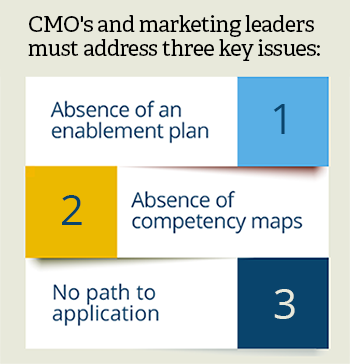CMOs: Stop Wasting Your Money on the Wrong Training
- CMOs and marketing leaders face a growing marketing skills gap that they must address
- A “spray and pray” approach to marketing enablement is insufficient, wasting resources and delivering suboptimal results
- Establish a path that connects newly acquired knowledge to application of the knowledge on an ongoing basis
SiriusDecisions defines marketing enablement as the process by which an organization systematically equips marketers with the necessary skills, knowledge, tools and processes to perform their roles.
 In my recent discussions with CMOs and marketing leaders, I discovered that only a small portion – 17 percent – have a marketing enablement process in place. However, that does not mean they are not trying different ways to upskill their teams, sending them to industry conferences, organizing workshops with internal or external subject matter experts, or procuring learning courses – and the list goes on.
In my recent discussions with CMOs and marketing leaders, I discovered that only a small portion – 17 percent – have a marketing enablement process in place. However, that does not mean they are not trying different ways to upskill their teams, sending them to industry conferences, organizing workshops with internal or external subject matter experts, or procuring learning courses – and the list goes on.
Although we encourage all types of creative and pragmatic ways of supporting marketing teams’ professional development, we continue to see such approaches deliver suboptimal results. To ensure enablement efforts are better positioned to achieve the desired impact, CMOs and marketing leaders must address three key issues:
- Absence of an enablement plan: Often, we select areas and topics for upskilling our teams based on industry hype or popularity. Instead, CMOs should ensure that enablement efforts are aligned to organizational strategies and objectives that marketing must support. That advice may sound obvious, but very few leaders have a disciplined and structured approach to make the necessary connection.
- Absence of competency maps: Of the CMOs and marketing leaders we spoke to, only 25 percent have competency maps in place. Competency maps are an essential part of creating and executing a successful enablement program, as they provide the roadmap of where you are and where you need to go, while identifying gaps you need to address. Would you board a plane if you were told that the pilot had no access to any navigation systems? I wouldn’t!
- No path to application: One of the questions I’m often asked is, “How can I evaluate the impact of sending my team to a conference (or conducting any other enablement activity)?” The typical approach is to seek feedback from attendees on the quality of the event or activity: Was the content high-quality? Were the tools relevant and applicable? Did you have good discussions with other attendees? And that’s where we typically stop, making it difficult to understand the impact of our enablement efforts. CMOs and marketing leaders must establish a clear path that lays out specific steps they expect their teams to take to apply their newly acquired knowledge. Let’s assume you trained your demand teams on best practices to drive their marketing tactical mix. Once the training is delivered, these are the steps we expect our teams to take:
- Immediately: Provide feedback on the actual training
- Within 30 days: Audit the current tactical mix and identify improvement opportunities
- Within 60 days: Use the degree of influence model that they were trained on to identify an improved, buyer-centric tactical mix
- Within 90 days: Select one or two new tactics to deploy, and establish measurements of success
- Within 120 days (and ongoing): Evaluate the performance of the new tactics, and incorporate learnings in the organization’s ongoing tactical mix planning.
This simple 30-60-90-120 days approach (intervals to be adapted as necessary) creates a clear connection among enablement, the application of the new knowledge and business impact. This establishes a clear accountability path for the CMO or marketing leader and his or her team.
Download an overview of the SiriusDecisions Marketing Enablement Process Model to build the foundation for marketing enablement to drive growth and the achievement of your goals.
